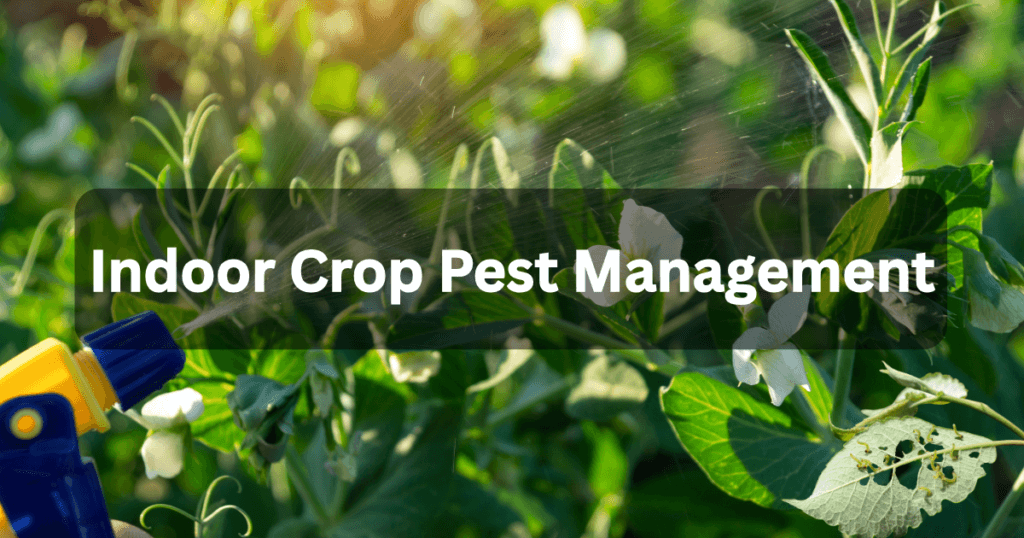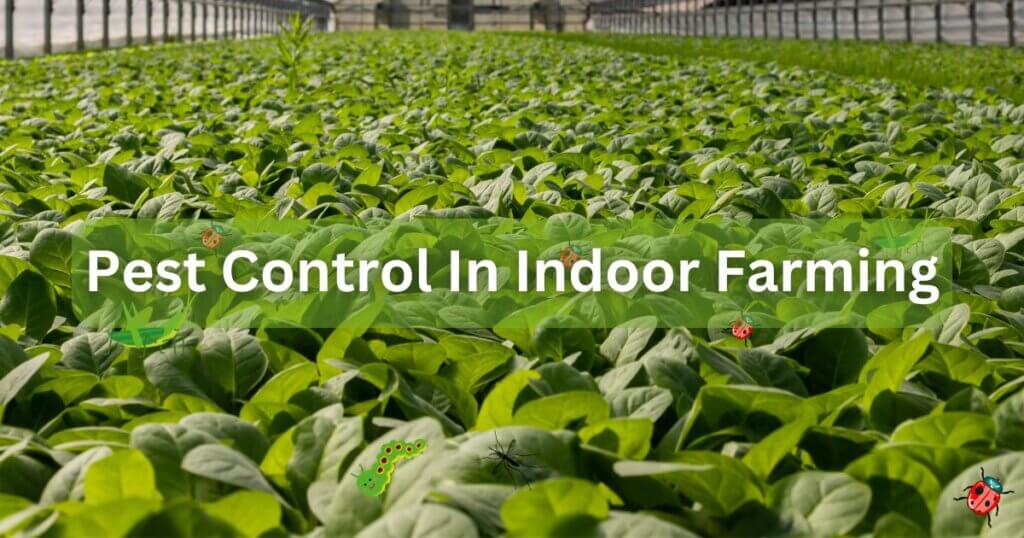7 Powerful Indoor Crop Pest Management Strategies That Actually Work

Some of the links in this post are affiliate links. As an Amazon Associate, we earn a referral fee from qualifying purchases—at no extra cost to you.
Table of Contents
Why Indoor Crop Pest Management Matters More Than Ever
Think pests aren’t a big deal indoors? Think again. Indoor farms may seem like secure sanctuaries, but tiny invaders like aphids, fungus gnats, and spider mites love your greens as much as you do. Without natural predators or environmental checks, pest problems can spiral fast. That’s why effective indoor crop pest management is crucial—not just to protect your plants, but to preserve your peace of mind.
Understanding Indoor Crop Pests: Know Your Enemies
Not all pests are created equal, and identifying the enemy is step one. Some of the most common indoor invaders include:
Aphids
These soft-bodied insects suck sap, weakening plant growth and spreading viruses. They reproduce rapidly in warm, humid environments—aka your grow tent.
Spider Mites
Tiny but mighty, spider mites spin webs and pierce plant cells, causing yellowing and stunted growth. They’re notorious for thriving in dry, dusty air.
Fungus Gnats
While adults are just a nuisance, their larvae feast on roots. Moist soil and organic matter create their perfect breeding ground.
Whiteflies
Hovering like tiny moths, whiteflies suck plant juices and leave sticky honeydew behind, which encourages mold growth.
How Pests Get Into Your Indoor Garden
Even if your setup is sealed tight, pests can sneak in. Here’s how:
- Contaminated plants or soil from nurseries or stores
- Open windows or doors allowing hitchhikers to enter
- Your clothes or pets carrying tiny intruders
- Unsterilized tools or containers
It’s like inviting bugs to a buffet without knowing it.
The True Cost of Pest Infestations in Indoor Farming
Let’s talk losses. Pests don’t just nibble on leaves—they slash your profits, kill plant morale (yep, stressed plants are a thing), and sabotage your yield. Some growers lose entire harvests before even realizing they had an infestation. Prevention isn’t just cheaper—it’s smarter.
7 Proven Indoor Crop Pest Management Strategies
Let’s dive into the tactics that make or break your indoor growing success.
Quarantine New Plants and Tools
Before adding anything new to your grow space, isolate it for at least 7 days. This gives pests time to reveal themselves so you don’t contaminate the whole crop.
Maintain Optimal Growing Conditions
Pests thrive in certain environments. Here’s how to outsmart them:
- Humidity: Keep it in check. Too much encourages fungus and gnats.
- Airflow: Use oscillating fans to make it harder for pests to settle.
- Temperature: Stay within the ideal range for your crops—many pests love heat.
Use Yellow Sticky Traps for Early Detection
Sticky traps aren’t just gross—they’re genius. Yellow attracts flying pests like whiteflies and fungus gnats. Place them near soil and canopy level to catch invaders early.
The Gideal Yellow Sticky Traps for Flying Plant Insects are pre-coated with a strong adhesive and designed to attract and trap whiteflies, fungus gnats, and aphids. These traps are highly effective for early pest detection and easy monitoring in indoor grow spaces.
Neem Oil and Insecticidal Soaps
For light infestations, neem oil is a game-changer. It disrupts insect hormones, halting their ability to eat or breed. Combine it with insecticidal soaps for a double punch—these break down pest membranes but are safe for plants.
The Bonide Ready-to-Use Neem Oil Spray acts as a 3-in-1 insecticide, fungicide, and miticide. It’s perfect for treating light infestations on indoor crops, and it’s OMRI-listed for organic gardening—just spray and go, no mixing required.
Introduce Beneficial Insects Indoors
Yep, even inside, you can fight bugs with bugs.
- Ladybugs: Devour aphids
- Predatory mites: Eliminate spider mites
- Encarsia formosa: Target whiteflies
These allies are tiny guardians of your indoor jungle.
Clean and Sanitize Regularly
Sanitation isn’t optional—it’s your first line of defense. Wipe down surfaces, sterilize pots, clean tools, and remove plant debris weekly. Think of it as pest-proofing your investment.
Rotate Crops and Monitor Often
Monocultures invite trouble. Rotate your indoor crops to confuse pests. And always monitor plant health with a magnifying glass. If something looks off—wilting, yellow spots, webbing—it probably is.
Organic and Natural Pest Management Techniques
If you’re going the organic route, your pest solutions should align. Here are natural pest deterrents that won’t harm your harvest:
- Cinnamon powder – antifungal and repels gnats
- Diatomaceous earth – microscopic shards that tear into soft-bodied pests
- Essential oils (peppermint, rosemary, eucalyptus) – aromatic deterrents for flying bugs
The Harris Diatomaceous Earth Food Grade powder includes a duster for easy application and works by dehydrating and killing pests like fungus gnats and aphids without using toxic chemicals.
The KUKKA essential oils is a powerful natural deterrent for many indoor pests. Mix it with water to create a safe, aromatic spray that repels flies, ants, and gnats.
Pest-Repelling Plants You Can Grow Indoors
Some plants pull double duty—they grow well indoors and repel pests naturally:
- Basil – wards off aphids and mosquitoes
- Lavender – deters moths and flies
- Mint – repels ants and aphids (but keep it contained—it spreads fast!)
- Chives – help keep aphids and spider mites away
Plant these as natural protectors in your indoor garden.
The Indoor Herb Garden Starter Kit comes with seeds for basil, mint, lavender, and chives—plants that not only thrive indoors but also naturally repel common pests like aphids, flies, and spider mites.
Using Technology for Smarter Pest Management
The future of indoor pest control is here—and it’s digital.
Automated Sensors and Cameras
Smart sensors can monitor humidity, temperature, and even detect pest movement. Some advanced systems alert you the moment pest activity is detected.
The Airthings Digital Humidity and Temperature Monitor provides real-time readings to help indoor growers maintain ideal climate conditions. This tech helps prevent environments that attract pests.
Mobile Apps for Pest Identification
Snap a pic of a bug and let an AI app identify it. Fast, accurate, and game-changing when time is of the essence.
Chemical vs. Biological Controls: Which is Better?
Chemical sprays may kill pests fast, but they come with side effects—resistance, residue, and potential plant damage.
Biological controls (like beneficial insects) work slower but keep your system balanced and safe for consumption. It’s about long-term sustainability vs. short-term convenience.
Indoor Hydroponics and Pest Control Tips
You’d think hydroponics is pest-proof—it’s not. Here’s how to deal:
- Cover reservoirs to block entry points
- Sterilize water systems between cycles
- Use net cups and hydroton to reduce moisture exposure
- Add hydrogen peroxide in low doses to sanitize roots
Hydroponics may lack soil, but pests still find ways in.
The General Hydroponics H2O2 Hydrogen Peroxide Solution is ideal for hydroponic systems. It helps sanitize root zones and nutrient reservoirs, reducing the risk of pest infestations without harming your plants.
Common Mistakes in Indoor Pest Control
We all mess up sometimes. Avoid these rookie mistakes:
- Ignoring signs of pests early on
- Overwatering (hello, fungus gnats!)
- Using outdoor soil indoors
- Relying on a single control method
- Skipping regular inspections
Stay vigilant—complacency is a pest’s best friend.
When to Call in the Experts
If you’ve tried everything and your plants still look like they’ve been through war, call in professionals. Certified pest control experts (who specialize in indoor agriculture) can identify hidden issues and offer tailored solutions without harming your crops.
Long-Term Pest Prevention for Indoor Farming Success
Indoor crop pest management isn’t a one-time fix—it’s a routine. Treat it like brushing your teeth or checking your grow lights. Consistency is key. Keep learning, testing, and adapting as your indoor garden evolves.
Conclusion: Take Control and Win the Pest Battle Indoors
Your indoor crops deserve a pest-free paradise. With the right strategies—from natural deterrents to smart tech—you can reclaim your growing space and stop bugs in their tracks. Don’t wait for pests to become a problem. Act early, act often, and trust your instincts. Your plants will thank you with lush, vibrant growth.
FAQs – Indoor Crop Pest Management
1. What are the best natural predators to introduce for controlling fungus gnats indoors?
Natural predators like predatory nematodes (Steinernema feltiae) and beneficial predatory mites (Hypoaspis miles) can effectively control fungus gnat larvae in the soil without harming your plants.
2. Can certain environmental adjustments completely prevent pest infestations in indoor farms?
While no method guarantees zero pests, maintaining optimal humidity, temperature, and airflow drastically reduces pest outbreaks by creating unfavorable conditions for their development.
3. How often should yellow sticky traps be replaced to maintain their effectiveness?
Yellow sticky traps should be replaced every 2 to 4 weeks or as soon as they become covered with insects or dust to ensure they continue attracting and trapping pests effectively.
4. Are there risks associated with using neem oil and insecticidal soaps on edible indoor crops?
Neem oil and insecticidal soaps are generally safe when used as directed, but it’s important to wash edible crops before consumption and avoid applying during flowering to prevent residue buildup.
5. What role can AI-powered pest identification apps play in indoor crop pest management?
AI apps allow growers to quickly and accurately identify pests from photos, enabling faster response times and more targeted pest control strategies, which can reduce crop damage.
Other Useful Resources Related To Indoor Crop Pest Management
1. https://extension.umn.edu/product-and-houseplant-pests/insects-indoor-plants
This University of Minnesota Extension guide offers practical, science-based tips for identifying and managing common indoor plant pests using non-toxic and sustainable methods.
2. https://farmonaut.com/usa/integrated-pest-management-5-proven-indoor-farming-strategies
Farmonaut outlines advanced Integrated Pest Management (IPM) strategies in indoor farming, including AI-based monitoring, biological controls, and automated systems.
3. https://kryzen.com/implementing-sustainable-pest-control-strategies-in-hydroponic-farming/
Kryzen shares sustainable pest control methods specifically for hydroponic and indoor farming, including biological agents, traps, and eco-friendly practices.
4. https://www.thespruce.com/sticky-plant-leaves-11730422
The Spruce discusses how sticky residues on leaves signal pest problems like aphids or mealybugs and provides natural remedies and prevention tips.
5. https://www.realsimple.com/how-to-get-rid-of-spider-mites-on-indoor-plants-8760612
Real Simple delivers easy-to-follow advice on identifying and removing spider mites from indoor plants using household solutions and improved humidity control.









